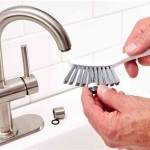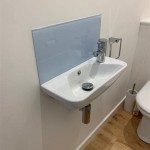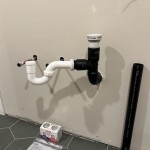How High to Stub Out a Bathroom Sink Drain
Stubbing out a bathroom sink drain involves extending the drain pipe from the sink's tailpiece to the point where it connects to the main drain line. The height at which this connection occurs, known as the stub-out height, is crucial for proper installation and drainage. An incorrectly positioned stub-out can cause slow draining, water backup, and even plumbing issues in the future. Understanding the factors influencing stub-out height and how to determine the ideal height is essential for a successful bathroom sink installation.
Factors Affecting Bathroom Sink Drain Stub-Out Height
The height of a bathroom sink drain stub-out is influenced by various factors, including:
- Sink Type and Placement: The type and placement of the sink influence the required stub-out height. Vanity sinks typically require a higher stub-out compared to pedestal or wall-mounted sinks, as the drain pipe needs to travel a longer distance to reach the main drain line. The location of the sink on the wall, the size of the vanity, and the presence of cabinets underneath can also impact the stub-out height.
- Plumbing Codes: Local building codes often specify minimum and maximum stub-out heights for bathroom sink drains. These codes are designed to ensure proper drainage and plumbing safety.
- Existing Plumbing: If you are replacing an existing bathroom sink, the stub-out height may be dictated by the existing drain pipe and its connection point to the main drain line.
- Trapping Requirements: Bathroom sink drains are required to have a P-trap, which prevents sewer gases from entering the house. The P-trap itself requires a certain minimum height to function correctly.
- Aesthetic Considerations: While not directly related to plumbing, the height of the stub-out can influence the overall look of the bathroom. For example, a low stub-out may be preferred for a pedestal sink to maintain a clean, streamlined appearance.
Determining the Ideal Stub-Out Height
To determine the ideal stub-out height for your bathroom sink drain, consider the following steps:
- Check Local Plumbing Codes: Consult with your local building department or a licensed plumber to determine the specific code requirements for stub-out heights in your area. These codes typically provide minimum and maximum height ranges for bathroom sink drains, ensuring proper drainage and plumbing safety.
- Measure the Sink's Drain Opening: Locate the drain opening in the bottom of your sink. Measure the distance from the bottom of the sink to the center of the drain opening. This measurement will serve as a starting point for determining the initial stub-out height.
- Consider the Sink's Placement: Take into account the position of the sink on the wall, any cabinets underneath, and the distance between the sink's drain opening and the main drain line. Factor in the vertical distance the drain pipe needs to travel to reach the main drain line.
- Allow for the P-Trap: Remember that the P-trap requires a certain minimum height to function correctly. Typically, the P-trap should be installed at least 18 inches below the sink's drain opening.
- Account for the Sink Tailpiece: The sink tailpiece connects the sink's drain opening to the drain pipe. The tailpiece typically has a length of 1 1/2 to 2 inches. Factor this length into your calculations when determining the stub-out height.
- Consult a Professional: If you are unsure about the ideal stub-out height for your bathroom sink, consult a licensed plumber. They can provide expert advice and ensure that the drain is properly installed and meets all code requirements.
Consequences of Incorrect Stub-Out Height
Incorrectly stubbing out a bathroom sink drain can lead to several problems, including:
- Slow Draining: If the stub-out is too high, the drain pipe may have insufficient slope, leading to slow draining and water backup in the sink.
- Water Backup: A low stub-out height can cause water backup in the sink. This occurs when the drain pipe is too close to the main drain line, creating a restriction and preventing water from flowing freely.
- Plumbing Issues: Incorrect stub-out heights can stress the drain pipe, leading to leaks, clogs, and other plumbing issues in the future.
- Aesthetics: A poorly positioned stub-out can affect the overall look of the bathroom, especially for visible drain pipes.
By carefully considering the factors influencing stub-out height and following the recommended steps, you can ensure a properly installed and functioning bathroom sink drain. Consult with a licensed plumber if you have any doubts or require professional assistance.
How Far Should A Drain Stub Pipe Stick Out Of The Wall Quora

What Is The Bathroom Sink Plumbing Rough In Heights

Pin On Bathroom Remodeling

Graywater Stub Outs Construction And Inspection Points

Bathroom Sink Pex Water Line Stub Out Drain Photo Master Bath Shower

What Is Correct Rough In Height For Sink Drains Quick Answer Measuring Tips

Pipe Placement 101 Fine Homebuilding

Graywater Stub Outs Construction And Inspection Points

What Is The Ideal Height For A Laundry Sink Stub Out

What Is The Standard Height For Rough In Bathroom Plumbing Green City Plumber
Related Posts







